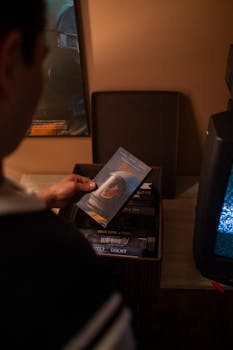Movies
The Art of Movie Posters: Why Design Still Matters
Movie posters are works of art that shape first impressions and build excitement while revealing story clues Learn how design techniques continue to define memorable cinema moments for audiences today
Advertisement
Most people recognize a great film by its memorable scenes, but the first impression usually comes from the poster hanging on theater walls. Movie posters play a major role in shaping expectations before a single scene rolls. Graphic design, color choices, and typography all set the mood for what’s ahead.
Every year, designers work to catch our eyes and imagination within a single frame. Movie posters have the power to stop someone in a crowded hall or make them pause scrolling online. Their legacy endures because they stretch beyond mere advertisements and become icons themselves.
This article invites you to appreciate how movie posters blend artistry and marketing, why their design details still matter, and what you can spot the next time you’re drawn to a poster. Dive in and see cinema from the perspective of graphic storytelling.
Spot Key Visual Elements for Immediate Impact
Knowing what makes a movie poster visually appealing helps anyone recognize design choices that influence audiences. Key elements like layout, color palette, imagery, and text placement guide the viewer’s eyes from top to bottom.
The designers behind movie posters follow specific rules for balance, rhythm, and visual hierarchy. Skillful use of contrast and fonts ensures important details pop while telling the story a film wants to introduce.
Balance and Symmetry Guide Viewer Attention
When you see a symmetrical movie poster, your eyes naturally land in the center. A designer might place the lead star or the main object right in the middle, anchoring the viewer’s focus immediately.
Asymmetry works differently. The dominant element—like a striking color block or a unique image—draws attention off-center, creating tension or intrigue. Designers use this intentionally to guide where your gaze travels.
This approach helps prioritize information. For instance, a large title in the upper third with faces arranged below creates a strong directional flow. Try noting eye movement next time you see a poster in a theater lobby.
Font Selection Sets Genre Expectations
Typography serves a powerful role on movie posters. Designers choose serif fonts for dramatic historical films and chunky sans-serifs for action-packed blockbusters, signaling what viewers can expect before watching.
An artfully selected font communicates genre instantly. For example, hand-lettered horror fonts create unease, while playful bubble letters hint at comedy. Matching font to tone avoids misleading audiences.
Compare how superhero films use bold, futuristic type, while indie dramas opt for understated, minimalist styles. This attention to detail supports movie branding from the very first glance in a crowded space.
| Poster Element | Effect on Audience | Movie Genre Typical Use | Design Takeaway |
|---|---|---|---|
| Color Palette | Establishes mood and tone | Horror – dark reds/blacks Romance – soft pinks/pastels | Match color to emotion the film aims to evoke |
| Imagery | Instantly signals plot or main theme | Action – protagonists in motion Documentary – real photos | Choose an image that encapsulates story core |
| Typography | Conveys film’s personality | Comedy – playful rounded fonts Drama – classic serif | Align font style closely with genre conventions |
| Composition | Directs viewer’s attention | Blockbusters – central figures Art films – experimental layouts | Use negative space or clusters to highlight stars or themes |
| Tagline Placement | Adds intrigue or clarifies plot | Thrillers – above/below title Animation – near characters | Tagline position should support main image and not clutter poster |
Build Emotional Connections Using Visual Storytelling
Emotional resonance is a core goal for every movie poster. Filmmakers want viewers to feel something strong in just one glance, and how they craft visuals to communicate these emotions is intentional.
Designers translate story themes into pictures—sometimes by focusing on a character’s facial expression, dramatic lighting, or a simple prop that becomes unforgettable. This is where movie posters move from ordinary marketing to subtle storytelling.
Iconography Creates Instant Recognition
Visual shorthand, such as iconic props or costume pieces, helps a movie poster stand out. When someone sees a fedora hat and whip, Indiana Jones comes to mind—even before reading a title.
This method ensures that with even a brief look, audiences identify beloved franchises immediately. Iconography lets you keep the design clean but memorable, a principle repeated in sequel posters to maintain brand recognition.
- Select recognizable symbols to anchor visual storytelling—think lightsabers in Star Wars or masks in superhero films—to draw instant connections.
- Rely on close-ups of key objects, not just faces, to evoke emotional responses tied to memory or nostalgia.
- Keep backgrounds clean when icons do the heavy lifting, ensuring attention centers on the emblematic detail without distraction.
- Repeat iconography in a film series to reinforce brand identity across years or decades of releases.
- Use subtle visual callbacks in posters, like a signature weapon, to reward fans and ensure consistent appeal on new entries.
These steps support filmmakers’ goals of building lasting emotional associations between imagery and audience experience.
Color Psychology Directly Shapes Viewer Reactions
Color selection isn’t accidental in movie posters. Using specific hues intentionally shapes how viewers feel: blue can imply mystery or sadness, while warm yellows spark hope or happiness.
For suspenseful films, shades of gray or red may dominate to boost tension. Designers pay close attention to marketing research linking color choices with audience responses, tailoring each poster to guide those gut reactions.
- Pick two to three primary colors that align with emotion—examples include deep blue for intrigue or golds for optimism.
- Contrast background and foreground colors to highlight headlines or images, making them easier to spot from far away.
- Incorporate color gradients when blending genres, like romance-thrillers, so posters evoke multiple layered feelings.
- Exclude excess hues to prevent visual overload, maintaining a clean, striking look that boosts comprehension.
- Adapt the poster palette for international markets if certain colors carry distinct cultural connotations or meanings abroad.
Sticking to deliberate color rules ensures movie posters get their emotional intent across instantly, even in crowded spaces or digital displays.
Story Moments Framed for Curiosity
Presenting a single frame that promises excitement or mystery urges viewers to dive into the full movie. Great movie posters hint at storylines and conflict using a carefully chosen moment, stirring curiosity. A powerful composition can do the heavy lifting for the film’s marketing.
Evoking Unanswered Questions Through Visual Clues
An effective way to build suspense is by showing, not telling. A poster might reveal a shadowy figure in the background or a mysterious object with no context. These storytelling clues encourage viewers to fill in gaps with their imagination, making them eager for answers.
Movies with unexpected plot twists often lean into visual ambiguity, letting viewers wonder what’s really at stake. The image becomes a puzzle—one you only solve when you watch the film. This strategy keeps interest high and creates conversational buzz.
Consider a poster for a detective film showing just a half-lit badge and an outstretched hand. This small detail tells you the genre and stakes, sparking curiosity about the story behind the scene.
Layered Scenes Build Anticipation Without Spoilers
Designers sometimes use layered imagery or subtle double-exposures to layer meaning without revealing big spoilers. For example, a character’s face might blend with a cityscape, hinting at their connection to the story’s setting.
This layered technique is particularly popular in psychological thrillers or films with multiple timelines. The audience gets a sense of complexity without knowing all the details—just enough to make them want more.
Choose a design technique that hints at, but never discloses, a pivotal event; this way, excitement builds for the story’s eventual reveal.
Layout Rhythm Directs Visual Engagement Step by Step
Movie posters rely on strong visual flow, ensuring every element guides the viewer’s eyes naturally. The best designs prioritize which parts draw attention first, followed by supporting details that enrich the story. Following deliberate layout rhythms helps designers make intentional choices about visual priorities.
Foreground vs. Background: Hierarchy in Poster Design
Foreground objects demand notice, so headshots or prominent symbols land closest to the viewer. Backgrounds provide context but rarely overshadow primary subjects. A crowded composition with too many foreground elements distracts, so designers pick what matters most.
Foreground dominance pairs well with minimal backdrops—think of simple, colored backgrounds in classic horror movie posters. This not only ensures the characters or objects pop but also establishes mood instantly.
When multiple storylines exist, designers may add small secondary images in the background—framed smaller or in faded colors—to hint at subplots, always without stealing focus from the main element.
Rule of Thirds: Structured yet Flexible Layouts
The rule of thirds guides where critical elements land. Divide the poster into a 3×3 grid, putting titles or key images along the intersection points for maximum impact. This position feels balanced and draws the viewer’s eye more naturally than strict center placements.
Action movies place actors’ faces along the top row and titles at the lower intersection, ensuring balance. Romance posters may position the main couple across a diagonal line, suggesting connection and movement.
This layout rule isn’t rigid. Designers break it when needed—sometimes off-center placement sparks more intrigue. The key is knowing both the rules and when a smart exception will stand out more.
Creative Direction Brings Stories Forward in Every Poster
We’ve explored how movie posters make lasting first impressions, drive emotion, and set expectations through color, imagery, and composition. Each strategic design decision transforms the poster into a concise piece of cinematic storytelling.
Understanding poster design enhances your enjoyment of movies while deepening your awareness of the artistry on display before you even see a trailer. Great movie posters become souvenirs of cinematic history, blending nostalgia and innovation.
The next time you see a new movie poster at your local theater or online, look for the choices made in composition, typography, and imagery. You’ll discover a deeper appreciation for why thoughtful poster design always matters.





